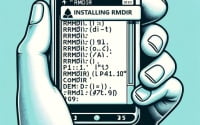Linux ‘free’ Command: Your Guide to System Memory Use

Are you finding it challenging to keep track of your Linux system’s memory usage? You’re not alone. Many system administrators and developers grapple with this task, but there’s a tool in Linux that can make this process a breeze.
Like a vigilant watchman, the 'free' command in Linux allows you to monitor your system’s memory usage. This command can provide you with a detailed overview of your system’s memory allocation, helping you understand where your memory is being used and how much is still available.
In this guide, we will walk you through the ins and outs of the ‘free’ command, from basic usage to advanced techniques. We’ll explore the ‘free’ command’s core functionality, delve into its advanced features, and even discuss common issues and their solutions.
So, let’s dive in and start mastering the ‘free’ command in Linux!
TL;DR: How Do I Use the ‘free’ Command in Linux?
The
'free'command in Linux can be used simply by entering the command into the terminal. It provides a snapshot of the physical and swap memory, as well as the buffers and caches used by the kernel.
Here’s a basic example:
$ free
# Output:
# total used free shared buff/cache available
# Mem: 16326428 7614148 4330644 460444 4377636 8083884
# Swap: 2097148 132540 1964608
In this example, we simply run the ‘free’ command, which outputs a table displaying the total, used, and free memory, along with the shared, buffer/cache, and available memory. This gives you a quick overview of your system’s memory usage.
But there’s much more to the ‘free’ command than meets the eye. Continue reading for a more detailed explanation and advanced usage scenarios.
Table of Contents
- Understanding the Basics of the ‘free’ Command
- Advanced Usage of the ‘free’ Command
- Exploring Alternative Commands for Memory Monitoring
- Troubleshooting the ‘free’ Command: Common Issues and Solutions
- Understanding Linux Memory Management
- The Broader Relevance of Memory Management
- Further Resources for Mastering Linux Memory Management
- Wrapping Up: Monitoring Memory with ‘free’
Understanding the Basics of the ‘free’ Command
The ‘free’ command is a simple yet powerful tool that can provide a snapshot of your system’s memory usage. Let’s start with a basic example and break down what each component means.
$ free -m
# Output:
# total used free shared buff/cache available
# Mem: 15931 7461 4242 450 4227 7916
# Swap: 2047 129 1918
In this example, we’ve added the -m option to the ‘free’ command. This option tells the command to display the memory usage in megabytes (MB), which is a more human-readable format.
The output table has several columns:
- Total: This is the total amount of physical memory and swap memory in your system.
- Used: This column shows the amount of memory currently being used.
- Free: This column shows the amount of memory that is currently not in use.
- Shared: This shows the memory used by tmpfs (temporary file storage).
- Buff/Cache: This shows the memory used by kernel buffers and cache.
- Available: This is an estimate of how much memory is available for starting new applications, without swapping.
Understanding these columns is crucial for effectively monitoring your system’s memory usage. In the next section, we’ll delve into more advanced uses of the ‘free’ command.
Advanced Usage of the ‘free’ Command
As you get more comfortable with the basic use of the ‘free’ command, you’ll find that it offers a wealth of additional features that can provide more detailed and customised information about your system’s memory usage. Let’s explore some of these advanced uses.
Before we dive in, here’s a quick reference table of some of the most commonly used flags with the ‘free’ command in Linux:
| Flag | Description | Example |
|---|---|---|
-b | Display the amount of memory in bytes. | free -b |
-k | Display the amount of memory in kilobytes. | free -k |
-m | Display the amount of memory in megabytes. | free -m |
-g | Display the amount of memory in gigabytes. | free -g |
--tera | Display the amount of memory in terabytes. | free --tera |
-h | Display the amount of memory in a human-readable format. | free -h |
-t | Display a line containing the totals. | free -t |
-s | Continuously display the report n seconds apart. | free -s 5 |
-c | Display the report n times. | free -c 5 |
--si | Use powers of 1000 not 1024. | free --si |
--wide | Display wide output. | free --wide |
--help | Display help information. | free --help |
--version | Display version information. | free --version |
Now that we have a basic understanding of ‘free’ command line arguments, let’s dive into some examples of its advanced usage.
Using the -h (Human Readable) Flag
One of the most commonly used flags is -h, which stands for ‘human readable’. This flag displays memory usage in a format that’s easier to understand because it automatically adjusts the units from bytes to kilobytes, megabytes, or gigabytes as needed.
$ free -h
# Output:
# total used free shared buff/cache available
# Mem: 15G 7.2G 4.1G 440M 4.0G 7.6G
# Swap: 2.0G 126M 1.9G
In this example, we can see that the memory usage is displayed in gigabytes (G), which is much easier to understand than the raw number of bytes.
Using the -t (Total) Flag
The -t flag adds a line at the end of the output that displays the total amount of physical and swap memory.
$ free -mt
# Output:
# total used free shared buff/cache available
# Mem: 15931 7461 4242 450 4227 7916
# Swap: 2047 129 1918
# Total: 17978 7590 6160
In this case, the total line shows the combined total of physical and swap memory, helping you get a complete picture of your system’s memory usage.
Using the -s (Seconds) and -c (Count) Flags
The -s flag followed by a number allows you to continuously display the memory usage at regular intervals specified in seconds. Combined with the -c flag, which specifies the number of times the data should be displayed, you can monitor the memory usage over time.
$ free -s 5 -c 3
# Output:
# total used free shared buff/cache available
# Mem: 15931 7461 4242 450 4227 7916
# Swap: 2047 129 1918
# total used free shared buff/cache available
# Mem: 15931 7461 4242 450 4227 7916
# Swap: 2047 129 1918
# total used free shared buff/cache available
# Mem: 15931 7461 4242 450 4227 7916
# Swap: 2047 129 1918
In this example, the ‘free’ command is run every 5 seconds, and this is repeated 3 times. This can be particularly useful for monitoring how memory usage changes in response to certain events or over a specific period of time.
Exploring Alternative Commands for Memory Monitoring
While the ‘free’ command is a powerful and popular tool for monitoring memory usage in Linux, it’s not the only game in town. There are other commands like ‘top’ and ‘vmstat’ that offer different perspectives and additional features. Let’s take a look at these alternatives and understand their advantages and disadvantages.
Monitoring Memory with the ‘top’ Command
The ‘top’ command provides a dynamic real-time view of a running system. It displays system summary information as well as a list of tasks currently being managed by the Linux kernel.
$ top
The ‘top’ command will show you a live, scrolling view of the current state of your system, including information about processes, CPU usage, memory usage, and more. However, it might be overwhelming due to the amount of information displayed.
Monitoring Memory with the ‘vmstat’ Command
The ‘vmstat’ command, on the other hand, reports information about processes, memory, paging, block IO, traps, and cpu activity.
$ vmstat 5 3
# Output:
# procs -----------memory---------- ---swap-- -----io---- -system-- ------cpu-----
# r b swpd free buff cache si so bi bo in cs us sy id wa st
# 1 0 132540 4327928 467552 4383088 0 1 11 30 68 110 2 1 97 0 0
# 0 0 132540 4327916 467552 4383088 0 0 0 0 100 214 0 0 100 0 0
# 0 0 132540 4327916 467552 4383088 0 0 0 0 100 214 0 0 100 0 0
In this example, vmstat is run with two numbers. The first number tells vmstat to refresh every 5 seconds, and the second number tells it to stop after 3 iterations. This command provides a more detailed view of your system’s memory usage, but it might be more complex to interpret for beginners.
While the ‘free’ command is an excellent tool for a quick snapshot of memory usage, the ‘top’ and ‘vmstat’ commands offer more detailed and dynamic views of your system. Choosing which command to use largely depends on your specific needs and how much detail you want to see.
Troubleshooting the ‘free’ Command: Common Issues and Solutions
The ‘free’ command in Linux is a reliable tool for monitoring memory usage. However, like any tool, it can sometimes present challenges or unexpected results. Let’s delve into some common issues you might encounter when using the ‘free’ command and how to address them.
Interpreting High Memory Usage
One common issue when monitoring memory usage is interpreting what it means when the ‘free’ command shows high memory usage. High memory usage isn’t necessarily a problem. Linux is designed to use your system’s memory to its fullest extent. Unused memory is wasted memory.
Buffers and caches are a good example of this. Linux will often use free memory to store frequently accessed data in buffers and caches to speed up system performance. This memory is still available to be used by applications if needed. If you see high memory usage in the ‘buffers/cache’ line, it’s generally nothing to worry about.
$ free -h
# Output:
# total used free shared buff/cache available
# Mem: 15G 7.2G 4.1G 440M 4.0G 7.6G
# Swap: 2.0G 126M 1.9G
In this example, even though the ‘used’ memory appears to be high, the ‘available’ memory shows that there is still plenty of memory available for new applications.
Monitoring Swap Usage
Swap usage can be another point of confusion. Swap space is used when your system runs out of physical memory. However, excessive swapping, known as ‘swap thrashing’, can significantly slow down your system. If you see high swap usage, it might be an indication that you need more physical memory.
$ free -h
# Output:
# total used free shared buff/cache available
# Mem: 15G 7.2G 4.1G 440M 4.0G 7.6G
# Swap: 2.0G 1.9G 126M
In this example, the ‘used’ swap space is quite high, indicating that the system is running out of physical memory.
Best Practices and Optimization
- Monitor Regularly: Regular monitoring can help you understand your system’s normal memory usage and identify any unusual patterns.
- Understand Your System’s Needs: Different systems have different memory needs. A database server might use memory differently than a web server or a desktop system.
- Use the Right Tools: The ‘free’ command is just one of many tools available for monitoring memory usage. Tools like ‘top’, ‘vmstat’, or ‘htop’ can provide more detailed or different views depending on your needs.
- Consider Configuration Changes: If you consistently see high memory usage, it might be worth considering a configuration change. This could involve adding more physical memory, adjusting the amount of swap space, or modifying how your applications use memory.
By understanding these common issues and considerations, you can use the ‘free’ command more effectively and keep your Linux system running smoothly.
Understanding Linux Memory Management
Before we delve deeper into the ‘free’ command, it’s crucial to understand the basics of Linux memory management. This knowledge will provide a better context for understanding the output of the ‘free’ command.
Physical Memory
The physical memory of a system refers to the actual RAM installed. When you run an application, it uses some of this physical memory.
$ free -h
# Output:
# total used free shared buff/cache available
# Mem: 15G 7.2G 4.1G 440M 4.0G 7.6G
# Swap: 2.0G 126M 1.9G
In this example, the ‘total’ under the ‘Mem:’ line shows the total physical memory, ‘used’ shows how much of the physical memory is currently being used, and ‘free’ shows how much physical memory is currently not being used.
Swap Space
Swap space is a portion of your hard drive that is allocated to be used as an extension of your physical memory. It’s used when your system runs out of physical memory. However, because hard drives are much slower than RAM, relying on swap space too much can significantly slow down your system.
$ free -h
# Output:
# total used free shared buff/cache available
# Mem: 15G 7.2G 4.1G 440M 4.0G 7.6G
# Swap: 2.0G 1.9G 126M
In this example, the ‘total’ under the ‘Swap:’ line shows the total swap space, ‘used’ shows how much of the swap space is currently being used, and ‘free’ shows how much swap space is currently not being used.
Buffers and Caches
Linux uses any free memory to store buffers and caches, which help improve system performance. Buffers are used by the kernel to temporarily store data from I/O operations, while caches are used to store frequently accessed data to speed up future requests for that data.
$ free -h
# Output:
# total used free shared buff/cache available
# Mem: 15G 7.2G 4.1G 440M 4.0G 7.6G
# Swap: 2.0G 126M 1.9G
In this example, the ‘buff/cache’ line shows the amount of memory used by buffers and caches. This memory is available to be used by applications if needed.
The ‘free’ command in Linux provides a snapshot of how these different components of your system’s memory are being used at any given time. By understanding these fundamentals, you can better interpret the output of the ‘free’ command and more effectively monitor your system’s memory usage.
The Broader Relevance of Memory Management
Understanding and effectively using the ‘free’ command in Linux is just one part of a larger picture. Memory management plays a crucial role in overall system performance and stability. When properly managed, memory can help your system run smoothly and efficiently. Conversely, poor memory management can lead to issues like slow performance, system instability, and even crashes.
The Impact on System Performance
Effective memory management is critical for optimal system performance. When a system is low on memory, it may start using swap space, which is significantly slower than physical memory and can cause a decrease in performance. By regularly monitoring memory usage with the ‘free’ command, you can identify potential issues before they impact system performance.
The Role in System Stability
In addition to performance, memory management also affects system stability. If a system runs out of memory and is unable to allocate more, it may become unstable or even crash. Again, the ‘free’ command can help you keep an eye on your system’s memory usage and ensure its stability.
Expanding Your Knowledge: Related Topics
While memory management is a crucial aspect of system administration, it’s not the only one. You might also be interested in related topics such as process management, which involves controlling and interacting with running processes, and disk usage monitoring, which focuses on managing and optimizing your system’s disk space.
Further Resources for Mastering Linux Memory Management
To deepen your understanding of memory management in Linux, consider exploring these additional resources:
- How to Get a Free, Buffer, and Cache Report in Linux: Baeldung presents a helpful guide on obtaining a ‘free’, ‘buffer’, and ‘cache’ report in Linux.
Linux Performance by Brendan Gregg: This resource offers a wealth of information on various aspects of Linux performance, including memory, CPU, and I/O.
Linux System Administration by Paul Cobbaut: This free book covers a wide range of Linux system administration topics, including memory management, process management, and disk usage monitoring.
Wrapping Up: Monitoring Memory with ‘free’
In this comprehensive guide, we’ve navigated through the intricacies of the ‘free’ command in Linux, a powerful tool that enables you to monitor your system’s memory usage effectively.
We started with the basics, exploring how to use the ‘free’ command to check memory usage. We then journeyed into more complex territory, learning how to use different flags to modify the output format or units. Along the way, we tackled common issues you might encounter when using the ‘free’ command, such as interpreting high memory usage and monitoring swap usage, and provided solutions to these challenges.
We also ventured beyond the ‘free’ command, looking at alternative methods to monitor memory usage in Linux, such as using the ‘top’ or ‘vmstat’ commands. Here’s a quick comparison of these methods:
| Method | Ease of Use | Level of Detail | Real-Time Monitoring |
|---|---|---|---|
| ‘free’ Command | High | Moderate | No |
| ‘top’ Command | Moderate | High | Yes |
| ‘vmstat’ Command | Low | High | Yes |
Whether you’re just starting out with Linux or you’re an experienced system administrator, we hope this guide has given you a deeper understanding of the ‘free’ command and its capabilities.
With its balance of simplicity and depth, the ‘free’ command is a powerful tool for monitoring memory usage in Linux. And with the knowledge you’ve gained from this guide, you’re well equipped to use this tool to its fullest potential. Happy monitoring!


